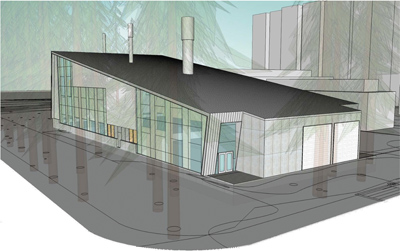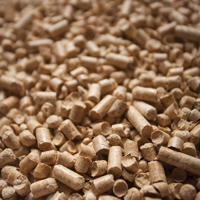
CHP at UBC – Ontario Pellets
June 15, 2010
By Stefanie Wallace and Treena Hein
This system will combine the gasification technology of Vancouver-based Nexterra Systems Corp. with GE Energy’s high-efficiency gas engines to convert local, clean woody biomass into heat and power for campus use.
This system will combine the gasification technology of Vancouver-based Nexterra Systems Corp. with GE Energy’s high-efficiency gas engines to convert local, clean woody biomass into heat and power for campus use.
 |
|
| This combined heat and power system will be the first demonstration of its kind in North America producing syngas. Nexterra CEO Jonathan Rhone says that a number of learning institutions in North America have shown interest in the system since the University of British Columbia announced the project. Illustration: Nexterra/UBC |
“In a standard biomass combustion-based combined heat and power (CHP) system, the biomass is burned to produce a hot flue gas that is used to produce high-pressure steam, which is then fed into a steam turbine to generate electricity, as well as hot water and/or low pressure steam,” says Jonathan Rhone, CEO of Nexterra. In contrast, with the system to be installed at University of British Columbia (UBC), the biomass will be gasified to produce a combustible fuel known as synthetic gas, or syngas. The syngas will then be further cleaned by Nexterra syngas conditioning technology and direct-fired into a GE Jenbacher high-efficiency engine that will produce electricity and heat.
Rhone believes this system will be a “game changer” for the CHP market. “Its high efficiencies, reduced emissions, and low operating costs enable a shift from large, centralized biomass plants to smaller, decentralized facilities,” he says.
Rhone claims that this CHP system can provide very high net efficiencies – up to 30% for power only and up to 60% in cogeneration mode – which results in significantly lower fuel costs per unit of energy generated. Because no high-pressure steam is involved, fewer or no steam engineers are required. These factors can help make the system economical at small scales of 2–10 MW.
Dave Woodson, managing director of building operations at UBC Vancouver, says the university has a few potential biomass suppliers in mind, including the city of Vancouver and UBC’s own research forest, and will likely use a broker to coordinate the details. The system is designed to produce 2 MW of power for the campus. It will also generate enough steam to displace up to 12% of the natural gas used for campus heating, reducing greenhouse gas emissions by up to 4500 tonnes/year.
Nexterra will install the CHP system equipment and provide the necessary training, startup, and performance testing, says Rhone. “UBC will be preparing the site, providing the foundations and building, as well as making all utilities connections to the building and new system.”
The UBC research facility has a number of bioenergy experts and resources available. An exciting part of the project is the new learning opportunities it will provide. It is beneficial to students who are training to become the next generation of engineers, says Woodson, noting that it’s important to see how far a creative or novel idea can go. This is the first of what UBC hopes will be many new projects for the campus in an effort to reduce greenhouse gas emissions. “The ultimate goal is to get our greenhouse gas emissions to zero,” he says.
“Through this collaboration, we intend to prove the technology at a commercial scale, standardize it, and then replicate it across British Columbia, Canada, and globally,” says Rhone.
“UBC is like a city,” adds Woodson. “We have this really neat opportunity to use the campus and view it as a community, where there aren’t multiple entities that would have competing interests,” he says. “There are a lot of people here supporting the project. We can work through any issues and use it as a means of demonstration, and show that these things can be done.”
Although some details of the project are still under negotiation, construction is expected to begin by mid-2010. The system is expected to be up and running by November 2011.
– Stefanie Wallace
Tillsonburg pellets
Canadian Biofuel is about to begin building a $5-million densified biomass fuel manufacturing plant in Springford, just north of Tillsonburg, Ontario, pending finalization of funding. Production of pellets and briquettes is planned for mid-August 2010. They’ll be destined for greenhouse boilers and residential stoves.
 |
|
| New pellet plants are planned for Ontario, where few pellets are made currently. They’re aiming to supply local residential heating and large-scale power generation markets.
|
Ian Moncrieff, president and CEO, is leading the project. “The site includes 20,000 square feet of warehouse space, an office, and seven silos that can hold 9,000 to 10,000 tonnes of pellets and briquettes,” he says.
A bagging plant will also be built. “Bags will be sold out of a showroom, where we’ll also provide the opportunity to purchase pellet stoves and boilers,” says Moncrieff.
The planned annual production capacity of the plant is 23,000 tonnes of briquettes and 27,000 tonnes of pellets. This volume is expected eventually to double. The production increase will likely be achieved by adding a third shift.
Although the final decision has yet to be made, the plant will likely use ring-die pellet-making technology. Moncreiff says that there are a couple of other technologies available in Canada (PSI in New Brunswick and IMI in Walkerton, Ontario), but after evaluating the options, he is leaning towards LaMeccanica of Italy.
The briquette-making system may be mechanical or hydraulic, says Moncrieff. Although he does not know of any Canadian densified-fuel briquetting technology currently on the market, he says, “there is a company in Waterloo, Ontario, that makes briquetting mills for other applications, and we are working with them to create a prototype.”
At first, cardboard, wood, and agricultural residues such as corn stalks and soybean straw will be used. The plant’s ultimate feedstocks, however, will consist of Miscanthus grass, prairie grass, switchgrass, and hybrid willow grown by local former tobacco farmers. It takes two to three years for these perennial crops to mature to the point that they can be harvested for feedstock. At six or seven tonnes of biomass per acre, more than 15,000 acres will be required to make 100,000 tonnes of product annually. The venture is also involved in a research study with Ontario Power Generation to investigate biomass options to supplement and replace coal by 2014 at the Nanticoke Generating Station.
– Treena Hein
Hearst Pellet Plant
Industries LacWood is preparing to open northern Ontario’s newest pellet plant. Normand Lacroix is president of Industries LacWood in Hearst, Ontario, a company of approximately 60 employees that manufactures wood products such as bed slats and shelving units.
Lacroix intends to expand his business by opening an internally operated pellet plant, which is expected to be fully running by June 2010.
“We are implementing this project to add value to the end cuts of the raw material we are already using,” says Lacroix.
According to Lacroix, Industries LacWood uses high-quality wood to make its products, and the pellets will be no different. At this point, the raw materials that will be used to produce the pellets will come strictly from the company’s factory.
“We put high importance on the quality of the raw material, which I think is something that will set us apart from other plants,” Lacroix says. He notes that the wood he uses is dried to 10% moisture content, and he intends for the pellets to have a high BTU content.
Industries LacWood will build most of the equipment used in the plant, with the exception of a hammermill and a pellet mill. The hammermill will process the raw wood before it’s fed into an electric-powered, all-in-one pelletizer that Lacroix has purchased from Sweden Power Chippers. The pelletizer will press out 6 mm by 2 cm pellets and then cool them. It has a production rate of one tonne/hour of pellets.
After researching various types of pellet mill, Lacroix decided that this particular machine would best suit his needs. “We have the knowledge and capacity to build the conveyor and everything else we need,” Lacroix says. “It is a fully internal project.”
Lacroix also purchased a Taylor scale and Fischbein sealer to package the pellets. They will be bagged on-site and distributed by Industries LacWood. Lacroix is planning to offer a variety of distribution options, including 30- to 40-lb bags, one-tonne bags, and large bulk bags.
Lacroix believes he will have no trouble supplying his targeted residential market. “We are expecting to produce about 7,000 tonnes/year,” he says. Although this is a small output compared to the larger-scale pellet plants, Lacroix doesn’t foresee a problem with developing his market. “It really will be a product produced in the north, for the northerners. The population here is more sensitive to green energy, so that is what we want to promote,” says Lacroix. Industries LacWood is interested in supplying to the agricultural industry, and Lacroix is looking into offering the pellets to greenhouses. There are no current plans to target an industrial market, but Lacroix has not dismissed that option.
– Stefanie Wallace
Print this page